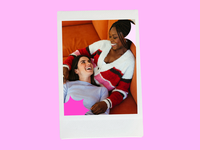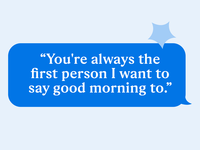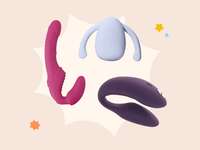The Enneagram Compatibility Pairings That (Supposedly) Make the Best Matches

There are plenty of ways you may try to gauge your compatibility with a potential match, be it through a dating app algorithm or what your respective zodiac signs have to say. One method that's been the subject of much obsession? Enneagram compatibility.
If you're unfamiliar with the concept of an Enneagram chart and what it means for relationships, here's the deal: The Enneagram system is a popular typology that, at a basic level, includes nine different personality types, each characterized by common strengths, motivations and core needs. Using this as a baseline, the idea behind Enneagram compatibility is to find the best match for your Enneagram type and to keep these distinct sets of characteristics in mind while navigating intimate relationships. Intriguing, no?
So, what Enneagram types are most compatible? And WTH does it mean for you and your partner if your types don't happen to fall amongst the best Enneagram matches? We're here to deliver all the deets, alongside a trio of Enneagram experts: Carrie Torn, LCSW, is a Certified Enneagram Approach Practitioner and uses the Enneagram system as a tool in her work as an anxiety and trauma therapist; Leslie Root, LMFT, is an individual and couples therapist specializing in Enneagram counseling and coaching; and Hanna B. Woody, MA, LCMHC, NCC, is an Enneagram-Certified Licensed Clinical Mental Health Counselor.
Here's what the pros have to say about Enneagram compatibility—and what it might mean for your relationship.
In this article:
- How Does Enneagram Compatibility Work?
- How to Find Your Enneagram Type
- Which Enneagrams Are The Most Compatible?
- Which Enneagrams Are The Least Compatible?
How Does Enneagram Compatibility Work?
"First and foremost," Carrie Torn, LCSW, explains, "knowing your own Enneagram type allows you to gain insight into why you do what you do…, our patterns of thinking, feeling and behaving, and, perhaps more importantly, the work we can do to change those default patterns and lead more fulfilling, expansive lives."
"Once you understand your own type," she continues, "you can also learn about the types of people you're in a relationship with—whether it's a romantic partner, friend, family member or coworker. This knowledge can help you empathize and have more compassion for their experience and understand their point of view."
Need to Find Your Enneagram Type?
You've got you, fam. Truity's free Enneagram test is one of the most popular in the US and is even psychologist-reviewed. You can find out your Enneagram type by taking Truity's short and simple Enneagram quiz here. For reference, the nine Enneagram types are as follows:
- Type One: The Reformer
- Type Two: The Helper
- Type Three: The Achiever
- Type Four: The Individualist
- Type Five: The Investigator
- Type Six: The Loyalist
- Type Seven: The Enthusiast
- Type Eight: The Challenger
- Type Nine: The Peacemaker
With that mission accomplished, you can find out more about the most compatible enneagram types below.
…Now, Back to Enneagram Compatibility
As each Enneagram type is characterized by certain traits and behaviors, some are more naturally complementary to—or clash with—other types. "For example," says Torn, "some types may have similar values and communication styles, making it easier to connect and understand each other, while others may have different priorities that can lead to misunderstandings."
Some individuals may also actively look for partners whose Enneagram type is thought to be compatible to theirs. But as Torn warns, "It's important to remember that compatibility is just one aspect of a successful relationship. Communication, shared values, mutual respect and emotional connection are also vital."
Which Enneagrams Are The Most Compatible?
When looking into what Enneagrams are compatible, keep in mind that Enneagram compatibility does not automatically equate to the success of one relationship or the failure of another. "It's important to remember that individual factors like communication skills, shared values and personal growth play a significant role in any relationship," explains Torn. And these various traits and factors vary from person to person, "even those who are the same Enneagram type," she notes. "We are all complex human beings who contain multitudes. "
Nevertheless, there are certain Enneagram-type pairings that are seen as naturally more compatible due to each partner's individual traits and the couple's shared or complementary behaviors, values or motivations.
Enneagrams Type 9 and Type 2
"This pairing is often highly compatible because both types are oriented towards harmony and connection," says Torn. "They tend to be supportive of each other's needs and work well together to create a harmonious environment."
Enneagrams Type 4 and Type 9
With Type 4s characterized as being deep and creative thinkers and the calming and accepting presence of Type 9s, this combo is seen as being an ideal match. "Together, they can create a space where emotions are acknowledged and understood, fostering a sense of mutual acceptance," says Torn.
Enneagrams Type 6 and Type 1
Since Type 6 is known as the "Loyalist" of the Enneagram system, a Type 1's desire for structure and reliability may attract them to this ride-or-die personality type. According to Torn, "Their shared commitment to responsibility and values can create a strong bond."
Enneagrams Type 7 and Type 2
"A Type 7's optimism can help a Type 2 stay engaged and enthusiastic," says Torn. Meanwhile, Type 2s can often provide the emotional support and connection that is typically seen sought by Type 7s.
Which Enneagrams Are The Least Compatible?
As Enneagram counselor Leslie Root, LMFT, emphasizes, "Any Enneagram typings can be compatible if each individual has a high level of self-awareness. There are no, so to speak, 'perfect pairings.'"
"That being said, there are common pairings and pairings that tend to run into more challenges," she says.
Enneagrams Type 3 and Type 8
"These are two assertive types who both want to run the show," says Root. Typically, she says, "Type 3s will be turned off by a Type 8's brashness, while a Type 8 may complain about a Type 3's tendency to focus on appearances."
Enneagrams Type 7 and Type 3
"As friends, this can be an awesome pairing," says Root. "As romantic partners, it's tough: They both are assertive types and have different ways of asserting themselves."
"Type 7 wants a lot of intellectual space and will rely heavily on logic and low on commitment," explains Root. "Meanwhile, Type 3s will want to feel connected and appreciated for all of their talents and gifts."
Enneagrams Type 2 and Type 5
"Type 2 is emotionally giving and nurturing, while Type 5 is more reserved and analytical," says Torn. "They may struggle with communication, as a Type 5's need for independence can sometimes clash with a Type 2's desire for closeness."
To strengthen a relationship between these two Enneagram types, Torn shares the following advice: "A Type 2 can respect a Type 5's need for personal space, and a Type 5 can work on expressing their feelings and needs more openly."
Enneagrams Type 9 and Type 6
"Both types seek security and stability, but they may have different approaches," explains Torn. "Type 9 tends to avoid conflict, while Type 6 may worry and seek reassurance. This combination may need to work on addressing concerns openly and honestly to avoid underlying tension."
Remember…
While Enneagram compatibility can be a helpful tool in learning more about yourself, your partner and your relationship, keep in mind that it is just that—a tool, not a set of hard-and-fast rules. "We all take in the world differently and the Enneagram provides us with a tool to understand these strengths and differences in ourselves and others," says Root. "No two perspectives are quite the same."
But as Hanna B. Woody, MA, LCMHC, NCC, is sure to point out, "Compatibility has a lot more to do with each individual's level of self-awareness, communication skills, and relationship needs."
"The Enneagram can help with all of these things and help couples learn what their needs are and how to support each other," Woody explains. "[Therefore], all types can be great in relationships together."
On a similar note, Woody says, "All types can also be chaotic and in negative relationships together. This has more to do with each individual's level of health within their own Enneagram type, rather than being partnered with the 'right' type."
The TLDR; of it?
If Enneagram compatibility piques your interest, use it to explore your communication styles, patterns of behavior and the like—and not to write off certain Enneagram types or relationships.
"It's helpful to explore the strengths of each [partner's] type, as well as the weaknesses, so each partner can see where they benefit the relationship and where they might be getting in their own way," explains Root.
"Foundational tools are fundamental in having a successful relationship," she says, adding that, "Couples coaching and therapy can be a great way to make sure you get the relationship you want and support you with learning the tools you will need for a long-term successful relationship."




















